Audi A4: Difference between revisions
| Line 78: | Line 78: | ||
| align="left" | 1.8 I4 [[multi-valve|20v]] [[overhead camshaft#double overhead camshaft|DOHC]] || {{convert|125|PS|kW bhp|0|abbr=on}} || {{convert|173|Nm|0|abbr=on}} || {{convert|205|km/h|1|abbr=on}} || 10.5 sec || 1994–2001 || 182 g/km |
| align="left" | 1.8 I4 [[multi-valve|20v]] [[overhead camshaft#double overhead camshaft|DOHC]] || {{convert|125|PS|kW bhp|0|abbr=on}} || {{convert|173|Nm|0|abbr=on}} || {{convert|205|km/h|1|abbr=on}} || 10.5 sec || 1994–2001 || 182 g/km |
||
|- |
|- |
||
| align="left" | 1.8T I4 20v DOHC [[turbocharger|Turbo]] || {{convert|150|PS|kW bhp|0|abbr=on}} || {{convert|210|Nm|0|abbr=on}} || {{convert|221|km/h|1|abbr=on}} || |
| align="left" | 1.8T I4 20v DOHC [[turbocharger|Turbo]] || {{convert|150|PS|kW bhp|0|abbr=on}} || {{convert|210|Nm|0|abbr=on}} || {{convert|221|km/h|1|abbr=on}} || 7.5 sec || 1994–2000 || 182 g/km |
||
|- |
|- |
||
| align="left" | 1.8T I4 20v DOHC Turbo || {{convert|180|PS|kW bhp|0|abbr=on}} || {{convert|235|Nm|0|abbr=on}} || {{convert|231|km/h|1|abbr=on}} || || 1999–2001 || 194 g/km |
| align="left" | 1.8T I4 20v DOHC Turbo || {{convert|180|PS|kW bhp|0|abbr=on}} || {{convert|235|Nm|0|abbr=on}} || {{convert|231|km/h|1|abbr=on}} || || 1999–2001 || 194 g/km |
||
Revision as of 19:16, 29 January 2010
| Audi A4 | |
|---|---|
 | |
| Overview | |
| Manufacturer | Audi AG |
| Production | 1994 – present |
| Assembly | Ingolstadt, Germany |
| Body and chassis | |
| Class | Compact executive car |
| Layout | longitudinal front engine, front-wheel drive, or quattro permanent four-wheel drive |
| Platform | Volkswagen Group B platform series |
| Related | Audi S4 Audi RS4 Volkswagen Passat Skoda Superb SEAT Exeo |
| Chronology | |
| Predecessor | Audi 80 |
The Audi A4 is a compact executive car produced by the German car manufacturer Audi AG since late 1994. The initial generation A4 succeeded the four previous generations of the Audi 80. And just like its Audi 80 predecessor, the Audi A4 automobile layout consists of a longitudinally orientated engine at the front, with transaxle-type transmissions mounted immediately to the rear of the engine, again, orientated longitudinally. Drive output is transmitted to either the front wheels, or on some models, utilising Audi's 'trademark' quattro permanent four-wheel drive system via a Torsen centre differential.
Since its inception, the Audi A4 has been available in four generations, based on the Volkswagen Group 'B' series of automobile platforms - usually known by the following codes - the initial B5, the subsequent B6 and B7, and the current B8.
Of the main body styles, it is (and always has been) available as a saloon/sedan variant, and an "Avant", which is Audi's name for an estate/wagon. The second (B6) and third generations (B7) of the A4 also had a Cabriolet version, but the Cabriolet was not retained for the current fourth generation (B8), due to the introduction of the Cabriolet version of the related Audi A5 and S5 coupés.
Additionally, higher performance versions directly related to the A4 include the Audi S4, and the limited availability quattro GmbH-developed very high performance Audi RS4.
B5 (Typ 8D, 1994–2001)
| Audi A4 (B5) | |
|---|---|
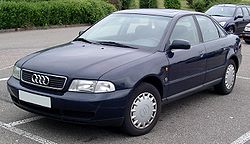 1994-1997 Audi B5 A4 saloon | |
| Overview | |
| Production | 1994–2000 |
| Model years | 1996–2000 |
| Body and chassis | |
| Body style | 4 door saloon/sedan, 5-door Avant (estate/wagon) |
| Platform | Volkswagen Group B5 (PL45) platform |
| Related | Audi S4 (B5), Audi RS4 (B5) Škoda Superb Volkswagen Passat (B5) |
| Powertrain | |
| Engine | petrol engines: 1.6 L I4 1.8 L I4 20v 1.8 L I4 20vTurbo 2.4 L V6 30v 2.6 L V6 2.8 L V6 2.8 L V6 30v; diesel engines: 1.9 L I4 TDI 2.5 L V6 24v TDI |
| Transmission | 5-sp manual; 4-sp automatic; 5-sp ZF 5HP19 automatic |
| Dimensions | |
| Wheelbase | 2,615 mm (103.0 in) |
| Length | 4,520 mm (178.0 in); Avant: 4,488 mm (176.7 in) |
| Width | 1,730 mm (68.1 in) |
| Height | 1,415 mm (55.7 in); Avant: 1,440 mm (56.7 in) |
| Chronology | |
| Predecessor | Audi 80 (B4) |
| Successor | Audi A4 (B6) |
This section needs additional citations for verification. (June 2008) |
The first-generation Audi A4 (known internally as the Typ 8D) was debuted by Audi in 1994, with production starting November 1994. It was built on the Volkswagen Group B5 (PL45) platform, which it shared with the fourth generation Volkswagen Passat (B5, Typ 3B). It had a front-mounted longitudinal engine and standard front-wheel drive, and many variations of the A4 were also available with Audi's 'trademark' quattro four-wheel drive system. The A4 was initially introduced as a four-door saloon/sedan; the Avant (estate/wagon) arrived a year later.
A wide range of internal combustion engines were available to European customers, between 1.6 and 2.8 litres for petrol engines; and a 1.9 litre diesel engine available with Volkswagen Group's VE technology, capable of achieving a 90 PS (66 kW; 89 bhp) or 110 PS (81 kW; 108 bhp), although Audi's 2.8 litre V6 engine, carried over from the old 80/90 was the only engine option in North America until 1997.
The Audi A4 was the first model in the Volkswagen Group to feature the new 1.8 litre 20v engine with five valves per cylinder, based on the unit Audi Sport had developed for their Supertouring race car. A turbocharged version produced 150 PS (110 kW; 148 bhp) and 210 newton-metres (155 lb⋅ft) torque. This technology was added to the V6 family of engines in 1996, starting with the 2.8 litre V6 30v, which now produced 193 PS (142 kW; 190 bhp).
Audi also debuted their new tiptronic automatic transmission on the B5 platform, based on the unit Porsche developed for their 964-generation 911. The transmission is a conventional automatic gearbox with a torque converter, but it offers the driver fully automatic operation, or manual selection of the gear ratios.
B5 facelift (1998–2001)



A refreshed B5 A4 range appeared at the 1997 Frankfurt Motor Show, with sales beginning in Europe in early 1998. Besides the introduction of a 2.8 litre 30-valve V6 engine (replacing the 2.8 litre 12-valve), the most important additions to the range were the 2.5 litre V6 Turbocharged Direct Injection (TDI) diesel engine with 150 PS (110 kW; 148 bhp) and standard quattro, and a six-speed manual gearbox, as well the new high-performance Audi S4, now part of the A4 lineup (the previous S4 had been an Audi 100). New rear lights, headlights, door handles, and other minor exterior/interior changes rounded out the cosmetic updates.
In mid 1998, the 1.8 20vT engine available outside Europe had its power output raised to 170 PS (125 kW; 168 bhp). The previous KKK K03 turbocharger, although fundamentally unchanged, did receive some revisions on the turbine side to prevent cracking due to heat.[citation needed] The 12-valve V6 was replaced by the 30-valve unit which had been available in Europe for two years.
In 1999, Audi debuted an even higher performance RennSport model, the RS4 Avant, like its predecessor RS2, available only in the Avant bodystyle.
B5 engines
The following engines were available:
| engine type | max. power | max. torque | top speed (saloon) | 0-100 km/h (62 mph) (saloon)(manual) | years | CO2 emissions[1] |
|---|---|---|---|---|---|---|
| petrol engines all fuel injected | ||||||
| 1.6 I4 8v SOHC | 101 PS (74 kW; 100 bhp) | 140 N⋅m (103 lbf⋅ft) | 190 km/h (118.1 mph) | 11.9 sec | 1994–2000 | 174 g/km |
| 1.6 I4 8v SOHC | 102 PS (75 kW; 101 bhp) | 148 N⋅m (109 lbf⋅ft) | 192 km/h (119.3 mph) | 11.9 sec | 2000–2001 | 192 g/km |
| 1.8 I4 20v DOHC | 125 PS (92 kW; 123 bhp) | 173 N⋅m (128 lbf⋅ft) | 205 km/h (127.4 mph) | 10.5 sec | 1994–2001 | 182 g/km |
| 1.8T I4 20v DOHC Turbo | 150 PS (110 kW; 148 bhp) | 210 N⋅m (155 lbf⋅ft) | 221 km/h (137.3 mph) | 7.5 sec | 1994–2000 | 182 g/km |
| 1.8T I4 20v DOHC Turbo | 180 PS (132 kW; 178 bhp) | 235 N⋅m (173 lbf⋅ft) | 231 km/h (143.5 mph) | 1999–2001 | 194 g/km | |
| 2.4 V6 30v DOHC | 165 PS (121 kW; 163 bhp) | 230 N⋅m (170 lbf⋅ft) | 226 km/h (140.4 mph) | 8.2 sec | 1997–2001 | 226 g/km |
| 2.6 V6 12v SOHC | 150 PS (110 kW; 148 bhp) | 225 N⋅m (166 lbf⋅ft) | 220 km/h (136.7 mph) | 9.1 sec | 1994–1997 | |
| 2.8 V6 12v SOHC | 174 PS (128 kW; 172 bhp) | 245 N⋅m (181 lbf⋅ft) | 230 km/h (142.9 mph) | 1994–1997 | ||
| 2.8 V6 30v DOHC | 193 PS (142 kW; 190 bhp) | 280 N⋅m (207 lbf⋅ft) | 240 km/h (149.1 mph) | 7.4 sec | 1997–2001 | |
| diesel engines all Direct Injection (DI) | ||||||
| 1.9 DI I4 8v SOHC | 75 PS (55 kW; 74 bhp) | 150 N⋅m (111 lbf⋅ft) | 170 km/h (105.6 mph) | 1996–2001 | ||
| 1.9 TDI I4 8v SOHC | 90 PS (66 kW; 89 bhp) | 202 N⋅m (149 lbf⋅ft) | 184 km/h (114.3 mph) | 13.3 sec | 1994–1997 | 125 g/km |
| 1.9 TDI I4 8v SOHC | 90 PS (66 kW; 89 bhp) | 210 N⋅m (155 lbf⋅ft) | 182 km/h (113.1 mph) | 13.3 sec | 1997–2001 | 143 g/km |
| 1.9 TDI I4 8v SOHC | 110 PS (81 kW; 108 bhp) | 225 N⋅m (166 lbf⋅ft) | 196 km/h (121.8 mph) | 11.3 sec | 1994–1997 | 114 g/km |
| 1.9 TDI I4 8v SOHC | 110 PS (81 kW; 108 bhp) | 235 N⋅m (173 lbf⋅ft) | 195 km/h (121.2 mph) | 11.3 sec | 1997–2000 | 114 g/km |
| 1.9 TDI I4 8v SOHC | 115 PS (85 kW; 113 bhp) | 285 N⋅m (210 lbf⋅ft) | 200 km/h (124.3 mph) | 10.5 sec | 2000–2001 | 123 g/km |
| 2.5 V6 TDI 24v DOHC | 150 PS (110 kW; 148 bhp) | 310 N⋅m (229 lbf⋅ft) | 220 km/h (136.7 mph) | 9.0 sec | 1997–2001 | 184 g/km |
B5 safety
In the Euro NCAP safety and crash tests, the Audi B5 A4 received 3 stars for front- and side-impact protection, but the last star is flagged to indicate that the driver may be subjected to a high risk of chest injury in the side impact.[2]
- Adult occupant =





- Pedestrian =



 (pre 2002 rating)
(pre 2002 rating)
B5 A4-derived hybrid version
In 1997, Audi was the first European car manufacturer to put a hybrid vehicle into series production, the third generation Audi duo, then based on the A4 Avant.[3][4]
B6 (Typ 8E/8H, 2001–2005)
| Audi A4 (B6) | |
|---|---|
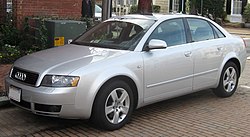 Audi B6 A4 sedan (US) | |
| Overview | |
| Production | 2000–2004 |
| Model years | 2001–2004 |
| Body and chassis | |
| Body style | 4-door saloon/sedan 5-door Avant (estate/wagon) 2-door Cabriolet |
| Platform | Volkswagen Group B6 (PL46) platform |
| Related | Audi S4 (B6) |
| Powertrain | |
| Engine | petrol engines: 1.6 L I4, 2.0 L I4 20v, 2.0L I4 FSI 16v; 1.8 L I4 20v Turbo; 2.4 L V6 30v, 3.0 L V6 30v; diesel engines: 1.9 L I4 TDI, 2.5 L V6 TDI, 3.0 L V6 TDI |
| Transmission | 5 and 6-sp manual; 5 and 6-sp automatic |
| Dimensions | |
| Wheelbase | 2,650 mm (104.3 in), Cabriolet: 2,654 mm (104.5 in) |
| Length | 4,547 mm (179.0 in), Avant: 4,544 mm (178.9 in); Cabriolet: 4,573 mm (180.0 in) |
| Width | 1,766 mm (69.5 in), Cabriolet: 1,777 mm (70.0 in) |
| Height | 1,428 mm (56.2 in), Cabriolet: 1,391 mm (54.8 in) |
| Chronology | |
| Predecessor | Audi A4 (B5) |
| Successor | Audi A4 (B7) |
This section needs additional citations for verification. (April 2009) |

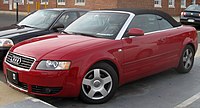

An all-new A4, internally designated Typ 8E, debuted in late 2000, now riding on the all-new Volkswagen Group B6 (PL46) platform. The car's new styling was inspired on the C5 (second-generation) Audi A6. The 1.6 litre base model remained unchanged, but most other petrol/gasoline engines received either displacement increases, or power upgrades. The 1.8 litre 20-valve Turbo was now available in two additional versions, with 150 PS (110 kW; 148 bhp) or 180 PS (132 kW; 178 bhp), this one with a standard six-speed manual gearbox, while the naturally aspirated 1.8 litre inline-four engine and 2.8 litre V6 were replaced by 2.0 litre, and all-aluminium alloy 3.0 litre units, still with five valves per cylinder, the most powerful of which was capable of 220 PS (162 kW; 217 bhp) and 300 newton-metres (221 lb⋅ft) of torque. The 1.9 Turbocharged Direct Injection (TDI) engine was upgraded to 130 PS (96 kW; 128 bhp), with Pumpe Düse (Unit Injector) (PD) technology, and was now available with quattro permanent four-wheel drive, while the 2.5 V6 TDI high-end model was introduced with 180 PS (132 kW; 178 bhp) and standard quattro. This generation of quattro consists of default of 50:50 front to rear dynamic torque distribution. A Bosch ESP 5.7 Electronic Stability Programme (ESP) system, with Anti-lock Braking System (ABS), brake assist, and Electronic Brakeforce Distribution (EBD) were standard across the range.
The Avant arrived in mid 2001.
For 2002, Audi upgraded power in the 1.8 Turbo engines to 163 PS (120 kW; 161 bhp) and 190 PS (140 kW; 187 bhp) - the 190 PS variant designated by a red 'T' on the boot lid, with both available with quattro, and in the 2.5 TDI intermediate version to 163 PS (120 kW; 161 bhp). A 2.0 engine with Fuel Stratified Injection (FSI) was also available. A year later, Audi reintroduced the S4, now powered by a 344 PS (253 kW; 339 bhp) 4.2 L V8 engine, as well as an A4 Cabriolet convertible variant (Typ 8H), finally replacing the 80-based Audi Cabriolet which had been discontinued in 1998. It included an electro-hydraulic operated roof, which lowered in under 30 seconds, and incorporated some styling changes which eventually found their way to the saloon version (such as body-colored lower bumper and sill panels).
Audi also introduced a continuously variable transmission developed by LuK, named multitronic, which replaced the conventional automatic transmission on front-wheel drive models. The transmission won considerable praise from the automotive press, and is generally regarded as being the best of its type in the world, due to its light weight and promptness in response, but its use was limited to models with a maximum of 310 N⋅m (229 lb⋅ft) of torque. The multitronic also requires more maintenance than either the manual or automatic transmissions - needing an oil change every 60,000 kilometres (40,000 mi).
Borrowing from the Audi A6, the boot was redesigned to remove the extension of the top edge with a smoother fold line, and the rear light assemblies now formed part of the top line.
An "ultra sport package" named 'Ultra Sport' was introduced in the North American market shortly before the B6 was replaced by the B7. It included aluminium interior trim and door sills, "S line" steering wheel, front and rear spoilers, side skirts, and quattro GmbH designed 18" RS4 alloy roadwheels.
B6 engines
The following engines were available:
| engine type | cyl. | max. power |
|---|---|---|
| petrol engines all fuel injected | ||
| 1.6 | I4 | 102 PS (75 kW; 101 bhp) |
| 2.0 16v | I4 | 180 PS (132 kW; 178 bhp) |
| 2.0 FSI 16v | I4 | 150 PS (110 kW; 148 bhp) |
| 1.8T 20v | I4 | 150 PS (110 kW; 148 bhp) or 163 PS (120 kW; 161 bhp) |
| 1.8T 20v 'S line' | I4 | 180 PS (132 kW; 178 bhp) or 190 PS (140 kW; 187 bhp) |
| 2.4 V6 30v | V6 | 170 PS (125 kW; 168 bhp) |
| 3.0 V6 30v | V6 | 220 PS (162 kW; 217 bhp) |
| diesel engines all Turbocharged Direct Injection (TDI) | ||
| 1.9 TDI | I4 | 100 PS (74 kW; 99 bhp) or 115 PS (85 kW; 113 bhp) or 130 PS (96 kW; 128 bhp) |
| 2.5 V6 TDI 24v | V6 | 155 PS (114 kW; 153 bhp) or 163 PS (120 kW; 161 bhp) or 180 PS (132 kW; 178 bhp) |
B6 safety
The Audi A4 (B6 & B7) passed the Euro NCAP safety and crash tests, and was awarded the following car safety ratings: [5]
- Adult occupant =





- Pedestrian =



 (pre 2002 rating)
(pre 2002 rating)
The IIHS awarded both the B6 & B7 a "Good" rating in the frontal crash test; the B7 was not retested since the front portion is structurally the same.[6]
B7 (Typ 8E/8H, 2005–2008)
| Audi A4 (B7) | |
|---|---|
 Audi B7 A4 saloon | |
| Overview | |
| Production | 2005–2008 |
| Model years | 2005–2008 |
| Body and chassis | |
| Body style | 4-door saloon/sedan, 5-door Avant (estate/wagon), 2-door Cabriolet |
| Platform | Volkswagen Group B7 (PL46) platform |
| Related | Audi S4 (B7), Audi RS4 (B7) SEAT Exeo |
| Powertrain | |
| Engine | petrol engines: 1.6 L I4, 1.8 L I4 20vT, 1.8 L I4 16v TFSI, 2.0 L I4 20v, 2.0 L I4 16v TSFI, 3.2 L V6 24v FSI; diesel engines: 1.9 L I4 TDI, 2.0 L I4 TDI, 2.7 L V6 TDI, 3.0 L V6 TDI |
| Transmission | 5 and 6-sp manual, 6-sp ZF 6HP tiptronic automatic, 7-sp multitronic CVT |
| Dimensions | |
| Wheelbase | 2,648 mm (104.3 in) |
| Length | 4,586 mm (180.6 in), Cabriolet: 4,573 mm (180.0 in) |
| Width | 1,772 mm (69.8 in), Cabriolet: 1,777 mm (70.0 in) |
| Height | 1,427 mm (56.2 in), Cabriolet: 1,518 mm (59.8 in) |
| Chronology | |
| Predecessor | Audi A4 (B6) |
| Successor | Audi A4 (B8) |
This section needs additional citations for verification. (April 2009) |
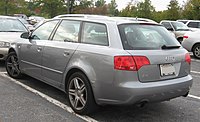


Audi introduced a revised A4 in late 2004, with the internal designation of B7. However, this new range A4 still utilised the existing Volkswagen B6 (PL46) platform, a chassis derived from the outgoing B6, but enjoyed heavily revised steering settings, suspension geometry, new internal combustion engine ranges, navigation systems and chassis electronics (including a new advanced Bosch ESP 8.0 Electronic Stability Programme (ESP) system). The front grille assembly has changed to be a tall trapezoidal shape in the same manner as the C6 (third-generation) Audi A6.
Audi's internal platform nomenclature uses PL46 (passenger car longitudinal platform, size 4, generation 6) for both B6 and B7 chassis. The Typ 8E and Typ 8H internal designations are also carried over from the B6 A4 range, but now have an additional identifying suffix - 8EC for the saloon, 8ED for the Avant, and 8HE for the Cabriolet.
The engine lineup received many additions. The 2005 introduction of Fuel Stratified Injection (FSI) on the 2.0 TFSI and 3.2 V6 FSI petrol/gasoline engines, as well as other refinements, increased power output to 200 PS (147 kW; 197 bhp) and 255 PS (188 kW; 252 bhp), respectively. These engines both implement a four-valve per cylinder design. The prior 5-valve design was incompatible with the FSI direct injection system (due to the siting of the fuel injector, now discharging directly into the combustion chamber). The 2.0 Turbocharged Direct Injection (TDI) diesel engine now combines Pumpe Düse (Unit Injector) (PD) technology with 16 valves for the first time, while the larger 2.5 TDI V6 diesel was superseded by a 3.0 V6 TDI, offering a 204 PS (150 kW; 201 bhp) model during the year 2005 which was upgraded to a 233 PS (171 kW; 230 bhp) model in 2006. A 2.7 V6 TDI was added later.
Torsen T-2 based quattro permanent four-wheel drive remained available on most A4 models. Audi retired its 5-speed manual transmissions in favour of a new Getrag 6-speed. As before, multitronic continuously variable transmission (CVT), now with selectable 'seven-speeds', is available on front-wheel drive models, whilst a conventional ZF 6HP 6-speed tiptronic automatic transmission is available on the quattro four-wheel drive models.
In addition to the higher-performance Audi S4, which carried over the powertrain from the B6 S4 - Audi has reintroduced the ultra-high performance quattro GmbH developed Audi RS4 (RS for RennSport) to the lineup, for the first time on the saloon/sedan and Cabriolet body, and with a naturally aspirated, but high-revving 4.2 litre V8 FSI engine. Another notable inclusion on the RS4 is the latest generation Torsen T-3 quattro 4wd system, which uses a 'default' asymmetric 40:60 front-rear dynamic torque distribution bias. This new asymmetric centre differential was initially only available on the RS4, but was added a year later on the S4. The remainder of the B7 A4 range still utilised the T-2 50:50 default dynamic split centre diff.
A limited edition variant, developed by quattro GmbH, was first introduced in May 2005, named "Audi A4 DTM Edition". It was inspired from Audi's race cars of the 2004 Deutsche Tourenwagen Masters, and was reintroduced in 2006 as a regular option. The 2.0T FSI engine received revised software mapping to the ECU, which increased the output to 220 PS (162 kW; 217 bhp) and 300 N⋅m (221 lb⋅ft) of torque. It was available with front-wheel drive, or quattro four-wheel drive.
The B7 Cabriolet model arrived later than the other two body variants, with sales beginning in February 2006. New on the Cabriolet was an entry-level 2.0 TDI version, but to date, this is not being offered with the multitronic CVT gearbox.
According to 2007 Swedish vehicle inspection data, the Audi A4 Avant with diesel engine is the most reliable vehicle available on the market, with vehicle inspection rejection rate of 0.0% in 3 year old category.[7] (Please note that although the Mitsubishi Galant estate, Volkswagen Touareg and Toyota HiAce Traveller share the rejection rate of 0,0%, A4's result is achieved with average mileage of over 111,000 kilometres (69,000 mi), while the average mileage for other cars achieving the 0,0% rejection rate is between 71,000 km (44,000 mi) and 77,000 km (48,000 mi).)
When its successor, the new B8 A4 range was introduced, the B7 series A4 was not destined for extinction - it was restyled and rebadged as the SEAT Exeo in 2008, with styling changes to the front and rear, also incorporating interior trim from the A4 Cabriolet. The entire Audi B7 A4 production line from Audis Ingolstadt plant was dismantled and sent to Volkswagen Group's related SEAT factory in Martorell, Spain.[8]
B7 engines
The following internal combustion engines were available:
| engine type / drive |
max. power | saloon | Avant | Cabriolet | 0-100 km/h (62 mph) (saloon) |
top speed (saloon) |
|---|---|---|---|---|---|---|
| petrol engines all fuel injected | ||||||
| 1.6 | 102 PS (75 kW; 101 bhp) | 12.6 sec | 120 mph (193 km/h) | |||
| 2.0 | 130 PS (96 kW; 128 bhp) | 9.9 sec | 131 mph (211 km/h) | |||
| 1.8T | 163 PS (120 kW; 161 bhp) | 8.6 sec | 141 mph (227 km/h) | |||
| 1.8T quattro | 163 PS (120 kW; 161 bhp) | 8.7 sec | 140 mph (225 km/h) | |||
| 2.0T FSI | 200 PS (147 kW; 197 bhp) | 7.3 sec | 149 mph (240 km/h) | |||
| 2.0T FSI quattro | 200 PS (147 kW; 197 bhp) | 7.2 sec | 147 mph (237 km/h) | |||
| 2.0T FSI DTM Edition | 220 PS (162 kW; 217 bhp) | 7.1 sec | 154 mph (248 km/h) | |||
| 3.2 V6 FSI | 256 PS (188 kW; 252 bhp) | 6.8 sec | 155 mph (elec. limited) | |||
| 3.2 V6 FSI quattro | 256 PS (188 kW; 252 bhp) | 6.4 sec | 155 mph (elec. limited) | |||
| diesel engines all Turbocharged Direct Injection (TDI) | ||||||
| 1.9 TDI | 115 PS (85 kW; 113 bhp) | 11.2 sec | 124 mph (200 km/h) | |||
| 2.0 TDI | 140 PS (103 kW; 138 bhp) | 9.7 sec | 131 mph (211 km/h) | |||
| 2.0 TDI | 170 PS (125 kW; 168 bhp) | 8.6 sec | 141 mph (227 km/h) | |||
| 2.0 TDI quattro | 170 PS (125 kW; 168 bhp) | 8.5 sec | 139 mph (224 km/h) | |||
| 2.7 V6 TDI | 180 PS (132 kW; 178 bhp) | 8.4 sec | 143 mph (230 km/h) | |||
| 3.0 V6 TDI quattro | 233 PS (171 kW; 230 bhp) | 6.8 sec | 153 mph (246 km/h) | |||
B7 safety
The Audi A4 offers many standard safety features, including Bosch ESP 8.0 Electronic Stability Programme (ESP) with Anti-lock Braking System (ABS), side airbags in the seats, 'sideguard' curtain airbags, and its optional quattro four-wheel drive system. It also received the Insurance Institute for Highway Safety (IIHS) "Top Safety Pick For 2007".[9][10] EuroNCAP crash test results from the B6 apply to the B7 model.
B8 (Typ 8K, 2008–present)
| Audi A4 (B8) | |
|---|---|
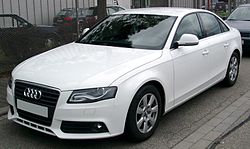 | |
| Overview | |
| Production | 2008–present |
| Model years | 2009–present |
| Assembly | Ingolstadt, Germany[11] Aurangabad, India (CKD)[12] |
| Body and chassis | |
| Body style | 4-door saloon/sedan, 5-door Avant (estate/wagon) |
| Platform | Volkswagen Group B8 (MLB/MLP) platform |
| Related | Audi A5, Audi S4 (B8), Audi Q5 |
| Powertrain | |
| Engine | petrol engines: 1.8 L TFSI I4, 2.0 L TFSI I4, 3.2 L V6 FSI; diesel engines: 2.0 L TDI I4, 2.7 L V6 TDI, 3.0 L V6 TDI |
| Transmission | 6-sp manual, 6-sp tiptronic automatic, 7-sp S tronic, 8-sp multitronic CVT |
| Dimensions | |
| Wheelbase | 2,808 mm (110.6 in) allroad: 2,805 mm (110.4 in) LWB: 2,869 mm (113.0 in) |
| Length | 4,703 mm (185.2 in) allroad: 4,721 mm (185.9 in) LWB: 4,763 mm (187.5 in) |
| Width | 1,826 mm (71.9 in) allroad: 1,841 mm (72.5 in) |
| Height | 1,427 mm (56.2 in) Avant: 1,436 mm (56.5 in) allroad: 1,495 mm (58.9 in) LWB: 1,426 mm (56.1 in) |
| Chronology | |
| Predecessor | Audi A4 (B7) |
Audi released the first official pictures of the B8 series A4 in August 2007, and unveiled the car to the public at the September 2007 Frankfurt Motor Show. Saloon/sedan and Avant (estate/wagon) models are offered. The Avant was unveiled to the public at the March 2008 Geneva Motor Show.
Land speed record
In 2009, Hohenester Sport announced its modified HS 650 Audi B7 A4 quattro had set a new world speed record of the fastest biogas-powered car of 364.6 km/h (226.6 mph) at the test track in cardboard castle, Niedersächsiches, driven by Jürgen Hohenester. The vehicle includes a 3.0 litre twin-turbo V6 engine, with electronically limited 700 PS (515 kW; 690 bhp) rating.[13]
Audi Sport A4 DTM
This section needs additional citations for verification. (April 2009) |
Audi Sport re-entered the Deutsche Tourenwagen Masters (DTM) series in 2004 (after having privateer teams run the Abt Sportsline Audi TT-R) with a V8 engined silhouette racing car resembling the A4 saloon, known as the Audi A4 DTM.[14]
In the past, Audi had used a V8 engine in the series with the original Audi V8 quattro, but had opted for a highly tuned V8 which Audi had no resources for. So Honda was contacted; at the time they had been using V8s in the Indy Racing League (IRL). Audi wanted a similar package in performance and reliability, so Honda and Mugen (M-Tec) got together and decided to let Audi use the Mugen/Honda MF308 V8 engine[15]. The only improvements made to the racing engine by Audi was shaving weight off the crankshaft, since the engine had already been designed from the ground up. Audi Sport prepped tested/implemented/approved and raced the engine in 2004, which produced 460 PS (338 kW; 454 bhp) and over 500 N⋅m (369 ft⋅lbf) of torque in 4.0 litre trim, and has been a mainstay in Audi's DTM programme.
A4 DTM cars are identified by Audi Sport "R"-prefix designations.[16] The following variants have been produced:
R11 (2004)
This section needs expansion. You can help by adding to it. (July 2008) |
The Audi R11 A4 DTM car resembled the B6 bodystyle of the Audi A4.
R12 (2005-2006)
This section needs expansion. You can help by adding to it. (July 2008) |
The Audi R12 A4 DTM car resembled the 2005 B7 bodystyle of the Audi A4. The R12 was revised for the 2006 season as the R12+.
R13 (2007)
The Audi R13 A4 DTM car also resembled the B7 bodystyle of the Audi A4.
- Engine: 4.0 Litre 90° V8 engine
- Power: 460 bhp (343 kW; 466 PS)
- Torque: over 500 N⋅m (370 ft⋅lbf)
- Gearbox: Xtrac or Hewland 6-speed sequential manual
- Chassis: Space frame developed by Dallara
- Tyres: Dunlop Race Tyres
- Front: 265/660-R18
- Rear: 280/660-R18
R14 (2008)
The Audi R14 A4 DTM car resembles the latest B8 bodystyle of the Audi A4, and includes the LED daytime running lights.
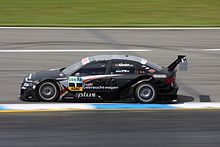
Technical specifications
- Chassis: Space frame, carbon-fibre composite driver's safety cell, carbon fibre composite front and rear crash structures must be FIA/DMSB approval safety cage.
- Engine: Custom-built Audi V8 engine, 4.0 litre, 90 degrees, 32-valve, 2xDOHC, 9,000 rpm rev-limit, 4-valves per cylinder.
- Pistons: Mahle.
- Filter: Dow.
- Power: 460 bhp (343 kW; 466 PS).
- Torque: over 500 N⋅m (370 ft⋅lbf).
- ECU: Bosch MS 2.9.
- Fuel: Aral Ultimate 100% octane (RON) super-unleaded.
- Fuel delivery: Fuel injection.
- Lubrication: Castrol, Shell Helix (#13 Alexandre Premat).
- Aspiration: Normally aspirated.
- Gearbox: Hewland sequential 6-speed sports gear (controlled DTM standard).
- Drivetrain: Rear-wheel drive.
- Clutch: Sandtler 3-plate carbon-fibre clutch.
- Radiator fluid: Würth.
- Steering: Servo assisted rack and pinion steering.
- Springs/Suspension: Eibach double wishbones front and rear, central wheel mounts, stabilisers front and rear, shock absorbers with adjustable drag and tow, power steering.
- Brakes: AP Racing hydraulic dual circuit brake system, light alloy brake calipers, front and rear ventilated carbon brake discs (DTM standard), driver adjustable infinitely variable brake-balance.
- Wheels: OZ forged alumminium.
- Front: 10 x 18".
- Rear: 11 x 18".
- 'Tyres: Dunlop SP Sport Maxx radial slick and treaded rain tyres.
- Front: 265/660-R18.
- Rear: 280/660-R18.
- Length: 4,800 mm (189.0 in).
- Width: 1,850 mm (72.8 in).
- Height: 1,200 mm (47.2 in).
- Wheelbase: 2,795 mm (110.0 in).
- Minimum weight: 1,050 kg (2,310 lb) (including the driver with overall and helmet).
- Fuel Capacity: 70 L (15.4 UK Gallons; 18.5 US Gallons).
- Safety equipment: Sabelt 6-point seatbelt, HANS Device.
- Ignition: Audi/Abt Sportsline CDI plug switchable on/off engine.
- Traction control: Yes.
- Team: Audi Sport Team Abt Sportsline, Phoenix Racing, Team Rosberg, Futurecom TME.
See also
References
- ^ Ultimate specs
- ^ "Audi A4". EuroNCAP.com. Retrieved 2008-06-01.
- ^ Audi.com Audi Q7 hybrid - making a clean start
- ^ Audi.com Audi Q7 hybrid concept - 15 years of pioneering work
- ^ "Audi A4". EuroNCAP.com. Retrieved 2008-06-01.
- ^ http://www.iihs.org/ratings/rating.aspx?id=163
- ^ Tuulilasi.fi Car unserviceabilities frequency sequence
- ^ Kirk, Julian (2008-11-04). "Seat Exeo (2009) CAR review". Car Magazine. Retrieved 2009-01-13.
- ^ IIHS.org IIHS-HLDI: Audi A4
- ^ IIHS.org TOP SAFETY PICK past winners
- ^ Audi UK site - production info
- ^ Audi A4 CKD assembled in India too
- ^ AutoBlog.com 227 MPH Audi A4 beats Bugatti to set world record for fastest car powered by biogas
- ^ Audi.co.uk The Audi A4 DTM
- ^ Racecar Engineering Oct 2007 - DTM: Worlds Closest Racing Saloon Series
- ^ Fourtitude.com forums Audi’s “R” numbers??
